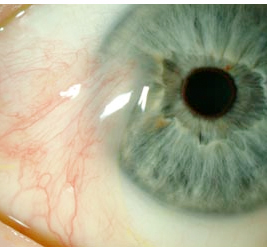What is Pterygium?
 Pterygium is a raised, wedge-shaped benign growth of the conjunctiva, the outer coating of the eye and most commonly occurs from the nasal side of the sclera, the white of the eye. The growth is normally a triangular thickening of the conjunctiva that grows onto the cornea. It can grow large enough to interfere with vision and frequently causes redness, tearing and irritation. It is most common among individuals who live in tropical climates having prolonged exposure to ultra-violet UV rays (sunlight); however, individuals in dry, dusty and windy environments also seem to be at a high risk. The exact cause of pterygium is not well understood but these aforementioned factors seem to play an important role. Hence, pterygium occurs more often in people who spend a great deal of time outdoors, particularly in sunny and dusty climates. A dry eye can also contribute greatly to pterygium.
Pterygium is a raised, wedge-shaped benign growth of the conjunctiva, the outer coating of the eye and most commonly occurs from the nasal side of the sclera, the white of the eye. The growth is normally a triangular thickening of the conjunctiva that grows onto the cornea. It can grow large enough to interfere with vision and frequently causes redness, tearing and irritation. It is most common among individuals who live in tropical climates having prolonged exposure to ultra-violet UV rays (sunlight); however, individuals in dry, dusty and windy environments also seem to be at a high risk. The exact cause of pterygium is not well understood but these aforementioned factors seem to play an important role. Hence, pterygium occurs more often in people who spend a great deal of time outdoors, particularly in sunny and dusty climates. A dry eye can also contribute greatly to pterygium.
Since pterygiums are most commonly caused by sun exposure, protecting the eyes from sun, dust and wind is highly recommended by wearing UV 400 rated sunglasses when outdoors. Instilling artificial tears liberally is also helpful to decrease irritation. In some cases, steroid drops are prescribed to reduce inflammation and redness.
Symptoms may include irritation, redness, and tearing. Pterygiums are nourished and fed by tiny capillaries that supply blood to the tissue. Symptoms can include persistent redness, inflammation, foreign body sensation, dry and itchy eyes. In advanced cases the pterygium can affect vision as it invades the cornea with the potential of an induced astigmatism and eventual corneal scarring. For some, the growth can remain dormant for some time; however, in other cases the condition can grow over the central cornea and adversely affect the vision. As the pterygium develops, it may alter the shape of the cornea, causing astigmatism as mentioned previously. If the Pterygium invades the central cornea covering the pupil, it can however be removed surgically.
There are a variety of options available to manage pterygium which include strontium (90Sr) plaque therapy, conjunctival auto-grafting or amniotic membrane transplantation. Considering it is a benign growth, pterygium typically does not require surgery unless the growth covers the pupil, thus effecting vision. Some of the irritating symptoms can be reduced with artificial tears. However, there is no reliable medical treatment that exists to date that prevents or reduces pterygiums. Surgical removal is one solution, however, consistent, long-term follow up is necessary to ensure that that the condition does not recur.
If pterygiums recur after surgical removal or if recurrence of pterygium is thought to adversely effect the vision, it is possible to use strontium (90Sr) plaque therapy using 90Sr, a radioactive substance which produces beta particles which penetrate a very short distance into the cornea at the site of the operation. This process contains the re-growth of blood vessels, which nourish pterygium. The treatment requires some local anaesthetic in the eye and is best done at the time of, or on the same day as the excision.
Conjunctival auto-grafting is a surgical procedure that is effective and safe in removing pterygium. When the pterygium is removed the tissue that covers the sclera known as the conjunctiva is also removed, auto-grafting replaces the bare sclera with tissue that is surgically removed normally from the inside of the individuals' upper eyelid. The tissue is then transplanted to the bare sclera and is attached using stitches, tissue adhesive or glue adhesive.
Amniotic membrane transplantation is an effective and safe procedure for pterygium removal as well and is an alternative to conjunctival auto-grafting. Amniotic membrane transplantation is tissue that is taken from the innermost layer of the human placenta and has been shown to have a strong anti-adhesive effect. AMT is an effective method of reconstruction for the repair of ocular surface disorders such as pterygium and the and reported data indicates that amniotic membrane transplantation facilitates shorter recovery and more comfortable removal making it a favorable alternative to conjunctival auto-grafting.
However, with so much information and new developments in surgical procedures and technologies, it is imperative for patients to consult with a physician before moving forward. An optometric physician can ascertain the stage of the condition and advise accordingly and how to go about treating and managing pterygium.
For additional information or to schedule an Eye Examination, please contact us at (866) 611-7556.
Serving:
Sealy, TX - Bellville, TX - Columbus, TX - Katy, TX |
